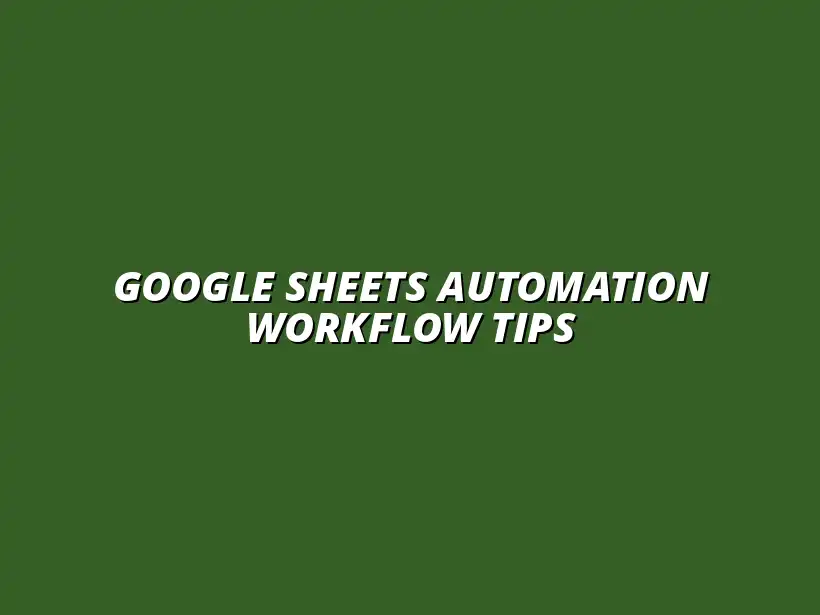
Google Sheets Automation Workflow Tips
Understanding Google Sheets Automation Workflows
Google Sheets automation workflows can be a game-changer for anyone looking to boost efficiency in their daily tasks. By automating repetitive processes, you can save time and reduce the risk of human error. Understanding how to effectively set up these workflows is essential for anyone who frequently uses Google Sheets.
In this guide, we will cover the fundamentals of Google Sheets automation, key components involved, and how to identify tasks that are perfect for automation. By the end, you’ll have a solid foundation to start creating your own automated workflows!
The Fundamentals of Google Sheets Automation
Automation in Google Sheets refers to using tools and scripts to perform tasks automatically without manual input. This can include anything from data entry to generating reports. By implementing automation, you can make your workflow more efficient and focus on more important tasks.
Some common methods of automation include using Google Apps Script and various add-ons. These tools allow you to streamline processes and improve the overall functionality of your spreadsheets. To learn more about streamlining your tasks, check out this helpful guide on streamlining your Google Sheets tasks.
What is Automation in Google Sheets?
Automation in Google Sheets helps cut down on repetitive tasks by allowing certain actions to happen automatically. For instance, you can set up a script to pull data from various sources and compile it into one sheet without lifting a finger!
Essentially, it takes over tasks that usually take up your valuable time, enabling you to work smarter, not harder. Here are a few examples of what automation can do:
- Automatically update data from other sheets
- Send email notifications for specific triggers
- Create charts and graphs based on real-time data
Benefits of Automating Your Workflows in Google Sheets
Automating your workflows in Google Sheets offers numerous perks that can significantly enhance productivity. First and foremost, it saves time, allowing you to focus on more critical tasks that require your attention.
Additionally, automation can lead to better accuracy in your data handling. When you automate processes, you minimize the chances of errors that often occur during manual data entry. Other benefits include:
- Improved collaboration among team members
- Consistent reporting and analysis
- Increased overall efficiency
Key Components of Google Sheets Automation Workflows
To create effective Google Sheets automation workflows, you need to understand the key components that make it all possible. Two of the most important elements are Google Apps Script and various add-ons.
These tools not only help you automate tasks but also enhance the overall functionality of Google Sheets, making it a powerful tool for data management and analysis. Learn how to automate Google Sheets with Apps Script to unlock its full potential.
Using Google Apps Script for Custom Automation
Google Apps Script is a powerful scripting language based on JavaScript which allows users to create custom functions and automate tasks in Google Sheets. With just a little bit of coding knowledge, you can create scripts that perform complex tasks automatically.
For example, you can set it up to run daily reports or update data at specific intervals. Here are some common uses of Google Apps Script:
- Automate data imports from APIs
- Send automated emails based on spreadsheet changes
- Create custom menus for specific tasks
Integrating Add-ons to Enhance Functionality
Add-ons can greatly expand the capabilities of Google Sheets and are often easier for those who may not be comfortable with coding. These are third-party applications that provide additional features you can seamlessly integrate into your existing sheets.
Using add-ons, you can enhance your automation workflow in various ways, such as:
- Importing data from other platforms like Salesforce or Trello
- Creating advanced charts and visualizations. Check out these Google Sheets data visualization tips to improve your reports.
- Connecting to external databases for real-time updates
Identifying Suitable Tasks for Automation
Not every task is suitable for automation, so it’s essential to identify which workflows will benefit the most. By analyzing your daily routines, you can pinpoint repetitive tasks that consume a lot of time and energy.
Once you have a clear idea of your tasks, you can begin the process of deciding which ones to automate. This can help you maximize your efficiency while ensuring you’re focusing on high-impact activities. Discover how to streamline tasks with Google Sheets for better results.
Common Workflow Scenarios for Google Sheets
There are several typical scenarios where automation can make a significant difference. Here are some common workflow situations in Google Sheets that are ideal for automation:
- Monthly financial reporting
- Tracking project timelines and milestones
- Data collection and analysis from multiple sources
Criteria for Selecting Tasks to Automate
When considering which tasks to automate, there are a few criteria to keep in mind. Firstly, tasks that are repetitive and time-consuming are prime candidates for automation.
Secondly, look for tasks where human error is likely to occur, as automation can help reduce those mistakes. Lastly, consider the potential return on investment from automating a task; if it saves significant time or improves quality, it’s worth pursuing! Learn how to automate tasks using Google Sheets efficiently.
Enhancing Efficiency Through Automation in Google Sheets
Common Challenges in Google Sheets Automation
When diving into Google Sheets automation, you might face several challenges. These obstacles can hinder your workflow and make it difficult to achieve the efficiency you desire. Identifying these challenges upfront can help you plan effectively and overcome them with ease!
Some of the most common issues include:
- Learning curve associated with Google Apps Script
- Integration difficulties with existing systems
- Data accuracy and formatting issues
- Limited support for complex automation needs
By recognizing these challenges, you can take proactive steps to address them and ensure a smoother automation process. This makes all the difference when it comes to achieving your efficiency goals!
Identifying and Overcoming Obstacles to Automation
Once you recognize the challenges in Google Sheets automation, the next step is to devise a plan to overcome them. To tackle these obstacles effectively, consider:
- Investing time in learning Google Apps Script or attending workshops
- Testing automation in smaller batches before full-scale implementation
- Utilizing community forums and resources for troubleshooting
- Collaborating with team members to share knowledge and skills
By focusing on these strategies, you can build a robust foundation for your automation projects. The key lies in being persistent and open to learning as you navigate through challenges!
Case Studies: Examples of Successful Automation Workflows
Sometimes, seeing real-life examples can inspire you to automate your own workflows in Google Sheets. Here are a few case studies that highlight successful automation:
- A marketing team that streamlined their weekly report generation, saving hours each week
- A small business that automated invoice processing to reduce manual errors and improve turnaround time
- A project manager who used automation to track task assignments and updates across multiple sheets
These examples demonstrate the potential of automation in Google Sheets to transform your work processes and enhance efficiency dramatically! For more on automating reports, see this guide on easily automating Google Sheets reports.
Frequently Asked Questions About Google Sheets Automation
As you consider diving into Google Sheets automation, you may have some questions. Let's address a couple of the most frequently asked ones!
What Types of Tasks Can Be Automated in Google Sheets?
The types of tasks you can automate in Google Sheets are numerous and varied. Here’s a quick list to give you an idea:
- Data entry and validation
- Generating reports and summaries
- Sending automated email notifications based on triggers
- Creating custom formulas for repetitive calculations
By exploring these options, you can identify which tasks could benefit from automation in your specific context. The possibilities are pretty exciting!
How Do I Get Started with Google Apps Script?
Getting started with Google Apps Script can feel overwhelming, but it doesn’t have to be! Follow these simple steps:
- Open your Google Sheet and click on "Extensions" then "Apps Script."
- Familiarize yourself with the built-in code editor.
- Start with simple scripts and gradually increase complexity as you learn.
- Utilize online resources, tutorials, and documentation to expand your knowledge!
As you build your skills, you’ll find that automation becomes more intuitive and effective over time!
Strategies for Scaling Automation Workflows
As your needs evolve, so should your automation strategies! Scaling your workflows effectively ensures you can keep up with growing demands.
Adapting Automation as Your Needs Change
To adapt your automation as needs change, consider the following:
- Regularly review your existing workflows for efficiency opportunities
- Stay updated on new features and updates in Google Sheets and Apps Script
- Solicit feedback from team members to identify gaps and areas for improvement
By embracing a mindset of continuous improvement, you can ensure your automation remains relevant and effective!
Integrating Other Google Workspace Tools for Broader Automation
Integrating other Google Workspace tools can significantly expand your automation capabilities. Here are a few tools to consider integrating with your Google Sheets:
- Google Forms for collecting data
- Google Drive for file storage and sharing
- Google Calendar for scheduling reminders and events
- Google Docs for generating customized reports
By leveraging the full suite of Google Workspace, you can create a more comprehensive and efficient automation strategy. The synergy between these tools is powerful! Effective data organization is key to successful automation. Learn more about organizing data with Google Sheets filters.
Reflections on Google Sheets Automation Workflows
Looking Ahead: Future Trends in Automation
As technology continues to evolve, so too does the landscape of automation in Google Sheets. Staying informed about future trends can position you at the forefront of this exciting field!
The Role of AI and Machine Learning in Google Sheets
The integration of AI and machine learning is expected to enhance the functionality of Google Sheets automation. Envision tools that can:
- Predict outcomes based on historical data
- Provide intelligent recommendations for data entry
- Automatically adjust formulas based on changes in your dataset
These advancements can make automating tasks even more seamless and intuitive, leading to a more efficient workflow!
Preparing for Continued Automation Innovations
To prepare for ongoing innovations in automation, consider these strategies:
- Engage in continuous learning and professional development
- Network with others in the field to share insights and experiences
- Subscribe to updates from Google regarding new features and tools
By staying proactive, you can ensure that your automation practices remain cutting-edge and effective!
Final Thoughts on Best Practices for Google Sheets Automation Workflows
As we wrap up, let’s summarize some key takeaways for successful automation in Google Sheets:
- Understand the fundamentals of automation before diving in
- Identify tasks that can genuinely benefit from automation
- Design workflows thoughtfully, keeping efficiency in mind
- Stay adaptable as needs evolve and technology advances
Embracing these practices can lead you to create efficient, effective workflows that not only save time but also boost productivity!
Call to Action: Start Automating Your Google Sheets Today
Are you ready to take the plunge into Google Sheets automation? Start small and progressively build your skills. The benefits of automation are just waiting for you to discover them!
Don’t hesitate to explore resources, seek help, and get started on transforming your workflows. Happy automating!




